GeoWorld Travel offers Geology Tours, geotourism holidays and day trips to the world's most interesting geosites.
Don't wanna be here? Send us removal request.
Text
Germany 2023: Volcanoes & Famous Fossil Sites
We returned to Germany in 2023 to run our “Volcanoes & Famous Fossil Sites” tour. This round-trip from Frankfurt takes in some world famous fossil specimens as well as volcanoes, meteor impact craters and ancient caves! For this trip, we were joined by guests from the UK and Ireland – unusually, six of our group already knew each other, as they were all members of the Irish Geological…

View On WordPress
#archaeopteryx#caves#fossil#Fossils#frankfurt#geology#geology holiday#geology tour#geopark#geotour#geotourism#Germany#ice age caves#messel pit#museums#volcano#Volcanoes#World Heritage Site
0 notes
Text
Canary Islands 2024: Volcanic Island Hopping
For those of us in the northern hemisphere, our winter trip to the Canary Islands offers a rare (and very welcome!) glimpse of the sun and temperatures well into double-figures. And, of course, it offers the chance to view some of the spectacular geology that these islands have to offer. We were delighted to welcome along a group of guests from the UK, the USA and Ireland for our trip in February…

View On WordPress
#Canary Islands#geology#geology holiday#geology tour#geotour#geotourism#la gomera#la palma#lava#lava tubes#tenerife#volcano#Volcanoes#World Heritage Site
0 notes
Text
Morocco 2023: The Trilobite's Sahara Kingdom
November 2023 saw the eighth running of GeoWorld Travel’s “The Trilobite’s Sahara Kingdom” trip to Morocco. We were delighted to welcome guests from the UK, the USA, Germany, Greece and the Netherlands on our latest geological adventure. We followed the same route as in previous years, journeying from Marrakesh, across the High Atlas via Zagora to Merzouga, before returning via the Todra Gorge to…
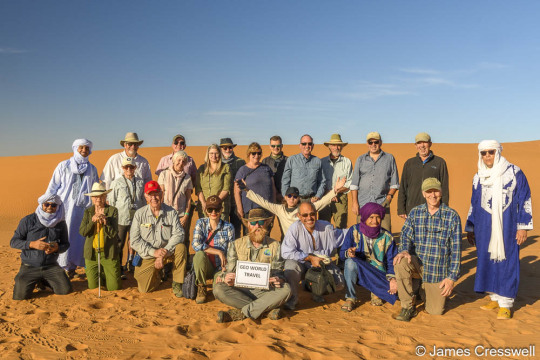
View On WordPress
#desert#fossil#fossil adventure#Fossils#geology#geology holiday#geology tour#geotour#geotourism#lagerstatte#marrakech#minerals#Morocco#sand dunes#stromatolites#trilobite#trilobites#World Heritage Site
0 notes
Text
Morocco 2021
GeoWorld Travel is just back from a 10-day geology tour of Morocco - here's the trip diary!
Morocco: The Trilobite’s Sahara Kingdom In November 2021, we returned to Morocco for the sixth running of our ‘Trilobite’s Sahara Kingdom’ tour. The route map for our ‘Trilobite’s Sahara Kingdom’ tour Day one – Arrival The tour officially started today as we welcomed a small group of guests from the UK and the USA. Despite the shifting sands of travel restrictions and testing requirements,…
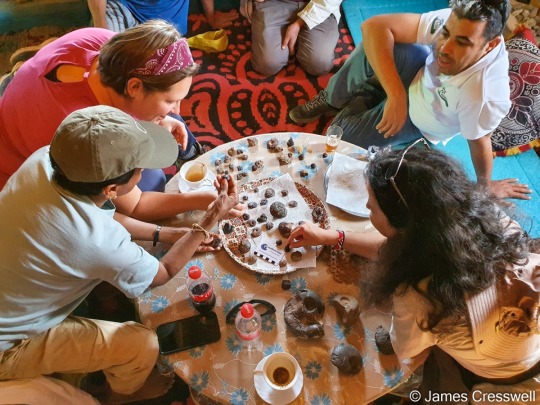
View On WordPress
#alnif#camels#desert#geology#geology holiday#geology tour#geotour#geotourism#marrakech#merzouga#minerals#Morocco#ouarzazate#trilobites#zagora
2 notes
·
View notes
Text
Scotland 2021
We've just published the blog of our recently completed geology tour of Scotland.
After a 14-month hiatus, due to the global pandemic, GeoWorld Travel finally got back on the road again, with a small group, socially distanced tour of the geology of Scotland. For geologists the world over, Scotland offers a wealth of outstanding geological sites and has been host to a number of crucial events in the history of geology. The route map for our ‘Birth of Geology’…

View On WordPress
#dinosaur footprints#Fingals Cave#geology#geology holiday#geology tour#geotour#geotourism#Moine Thrust#Scotland#Siccar Point#Staffa
0 notes
Photo

Merry Christmas & Happy New Year ☃️🎅🎄 (at Brecon Beacons) https://www.instagram.com/p/CJLhSxgpjm8/?igshid=lgos4zazbm6u
0 notes
Text
Oman 2020: Ocean Crust and Mountains of Mantle
We've just published the blog of our recent trip to Oman - hope you enjoy reading it!
Day one – Muscat to Al Mussanah
Our first full day of touring started at Wadi al Abyad, the best place in the world to see the Moho – the boundary between the earth’s crust and mantle. Here we saw a sharp contrast between the mantle rocks, consisting of a type of peridotite called hartzburgite, and the ocean crust rocks made of layered gabbro. So how is it possible to see such rocks at the…
View On WordPress
#al hoota cave#bahla fort#desert#geology#geology holiday#geology tour#geotour#geotourism#mother of all outcrops#muscat#nappe#Oman#ophiolite#peridotite#pillow basalts#sand dunes#Semail#wadi#wahiba sands
1 note
·
View note
Photo
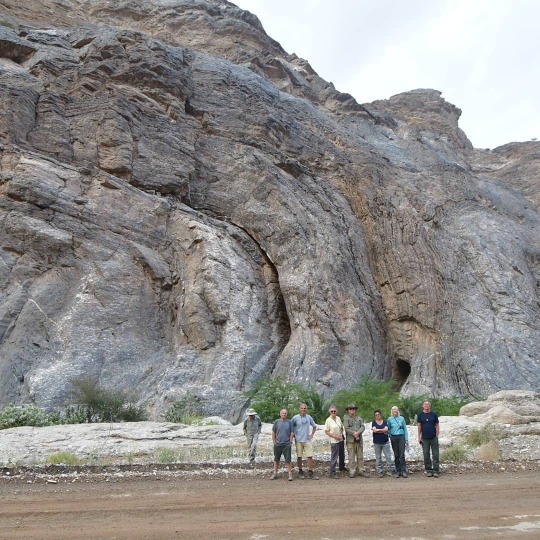
Monday was the final day of our Oman geology tour. Our first stop was a site 3.7m above current sea level, where marine erosion and marine organisms have carved a pitted notch into Eocene conglomerate (pic2). This level represent the high tide level in the Eemian interglacial (127,000 to 106,000 years ago), when global temperatures were several degrees warmer than today (and for example hippos lived in the Thames). Today we have already exceed Eemian CO2 levels, so this outcrop is a stark warning of what sea level rise is to come. The following stop was a series of Miocene wave-cut platform terraces (pic3) which are overlain by Quaternary fossil corals (pic4). The terraces have formed due to tectonic uplift. Next we arrived at Wadi Shab, a magnificent canyon cut into Eocene limestone, and is considered by many to be Oman’s most beautiful Wadi (pics 5&6). We spent two hours hiking in the wadi enjoying the wonderful scenery, we also had our picnic lunch here. We then visited a fascinating site with a tsunami deposit (pic7) Here huge boulders could be seen on top of a cliff. Some of the boulders were even stacked up (or ‘imbricated’), showing they had been washed into place by a giant wave! This was followed by a visit to the Bimmah Sinkhole (pic8), which is actually a doline. The surface rock is not soluble but the layer beneath is and, when a sinkhole formed in it, the surface rock crashed through leaving a doline. Our final stop of the tour, was at Wadi al Mayh to see the world’s largest sheath fold, which also contains many smaller isoclinal folds (pics 1&10). Sheath folds are associated with shear zones, in this case the the plate boundary along which the Semail ophiolite obducted. Normally they are only centimetre to meter in scale but this fold hinges along a 15 km long profile. Sheath folds are distinctive curvilinear folds in which the hinge actually wraps around on itself. In three-dimensions sheath folds look much like their name implies, a sheath that might holster a sword. When eroded, the tubular-shape of a sheath fold displays a characteristic eye-shape in cross section (pic9), and that is what can be seen on the slopes above Wadi Mayh. (at Oman) https://www.instagram.com/p/B9q_ksaJ2n1/?igshid=1jc3r31ifa1qy
0 notes
Photo

Today was the penultimate day of our tour. We awoke in our desert camp in the Wahiba Sands (pic2), and had to first navigate the dunes to reach a road again. The first stop was to see rocks of the Precambrian crystalline basement (800-1,000 million years old). Here we saw granites that formed as terranes were accreted together, cut by huge gabbro dykes (pic3) that were intruded as the basement went through a later period of extension. All of these rocks were themselves intruded by granitic pegmatite (containing large crystals) dykes (pic4). Our next stop was to see an ultramafic rock outcrop on the beach (pics 5&6), which contained volcanic fragments (lapilli) that formed due to the ascent of magma. Some authors have called the rock a kimberlite, which is the deepest mantle derived volcanic rock of all, and sometimes contains diamonds, although this outcrop contains no diamonds. Others argue this outcrop is actually a carbonatite which is also derived from deep in the mantle but less deep than kimberlite. After our picnic lunch, we then visited one of Oman’s most famous outcrops informally known as the ‘mother of all outcrops’ (pics 1,7&8). Here, red radiolarian chert is interbedded with white porcellanite. These sediments were deposited in water 4,000-4,500 metres deep, which is too deep for limestones to form so, but rocks can form from radiolaria plankton because their skeletons are made of silica. Our group discussed at length why the outcrop consisted of alternating white and red layers, was it a secondary diagenetic process? or was it directly due to cycles of sedimentation? However the sediments were deposited, they were later folded and faulted as they were thrust onto Arabia as part of the Batain Nappe, (along with the Oman’s other ophiolite, the Masirah Ophiolite), 15-20 ma after the emplacement of the main Semail Ophiolite. At our next stop, we saw an outcrop of manganese ore (pic9), which contained crystals of pyrolusite (MnO2). The final stop of the day was an outcrop of carbonite volcanic rock (pic10). The rock appeared to be a tuff (volcanic ash) rather than lava. The rock also contained beautiful veins of amethyst. (at Oman) https://www.instagram.com/p/B9oV6CPJ9Gk/?igshid=tzmrobeuec2u
1 note
·
View note
Photo
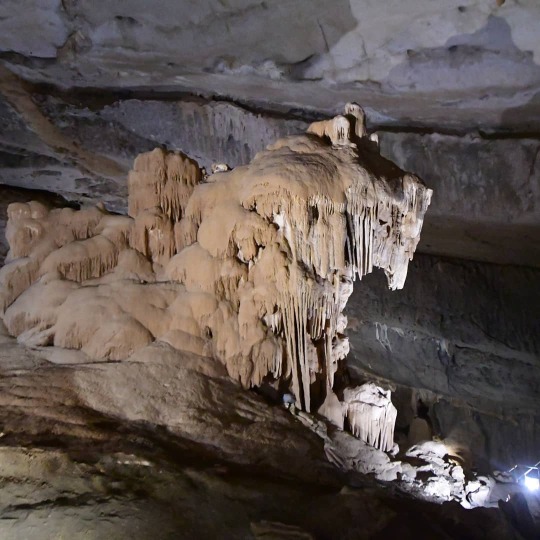
The 5th day of our #Oman tour started with a visit to the Bahla Fort World Heritage Site, (pics 2,3&4) which was built between the 12th and 15th centuries by the Banu Nebhan tribe who were known for controlling the frankincense trade at the time. The fort also sits on an outcrop of ophiolitic rocks and we were able to see peridotite cut by gabbro dykes (pic4). The next stop was Al Hoota Cave (pics 1&5) in the Hajar Mountains. The cave is the largest show cave in Arabia in sits in mid Cretaceous (Albian) aged limestones and dolomites. The cave has been formed by water flowing through tectonic fractures in the rock, and contains beautiful stalactites and stalagmites. After the cave, we visited another World Heritage Site, “The Aflaj Irrigation System of Oman” (pic6). This irrigation system is up to 4,500 years old and is seen as one of the driving forces behind the formation of Oman as a nation as it provided the reason for nomadic societies to settle down. After lunch we had a longer drive to the Wahiba Sands. En route we stopped at a site where we had a distant view of the Moho on a mountainside (pic7), with the bulk of the mountain made of peridotite but with the top capped by gabbro. We then had an exhilarating high speed drive into the Wahiba Sand dunes to reach a desert camp where we spent the night. Before the sun set we drove to the top of a nearby dune and watched it go down (pics 8&9). Here we also discussed dune formation. Our hosts at the camp then provided us with a lesson in traditional Bedouin Dance (pic10), dinner and a talk on Bedouin life and culture by a camp fire. (at Al Hoota Cave) https://www.instagram.com/p/B9l5UkupVd5/?igshid=12pq8n8fn20pg
0 notes
Photo

Today we focused on the rocks of the upper part of the Semail #Ophiolite. Our first stop was a fossilised Black Smoker (pics2-5) that was once on the ocean floor at a spreading ridge of a back-arc basin. The smoker could be seen from several miles away as a prominent red hill, the red colour being due to haematite. The structure was virtually all intact, and you could imagine diving down in a submarine to see it. We saw lots of malachite, and azure copper mineralisation and epidote too. It was possible to see tube like structures (pic3) where the hydrothermal acidic fluids would have forced their way through the rock. The site may have been lightly mined over the last 4000 years ago and the chimneys of the smoker were no longer present. Recent mining surveys have shown a copper ore body 20m x 250m x 100m lies directly under the structure. Our next stop was to look at basalt that had cooled just below the surface and had hexagonal cooling structures (pic6), that were weathering from the outside of the hexagons inwards. Next, we stopped for lunch at an outcrop that was 100% dykes (pic7). This is the sheeted dyke complex that forms at spreading ridges taking magma from the magma chamber below to the surface, and is characteristic of the classic ophiolite sequence. We then relocated to one of #Oman 's most famous geosites, the incredible “Geotimes” #PillowBasalts at Wadi al Jizzi (pics1&8). These are considered to be the best pillow basalt outcrops in the world. These basalts were erupted on to the seabed, and formed pillow structures as they were cooled by the sea water. Examining the pillows we were able to see their glassy outer skin, and two dykes that cut through them to feed younger basalts. We finished the day with a visit to a #coppermine (pic9) that had been mined for most of the last 4,000 years only stopping a few decades ago leaving a great hole in the ground, that would have once been a black smoker like the one we saw earlier in the day. A few hundred metres from the mine is what may be the only ziggurat in Arabia (pic10). A #ziggurat is a stepped pyramid, and it would have been built by early copper miners who travelled to Oman from Mesopotamia. (at Wadi Al Jizi Power Company) https://www.instagram.com/p/B9UV_C1JARW/?igshid=nclcjhn7hbq1
0 notes
Photo

Our first full day of touring started with at Wadi al Abyad, the best place in the world to see the #Moho – the boundary between the earth’s crust and mantle. Here we could see a sharp contrast between the #mantle rocks, consisting of a type of #peridotite called #hartzburgite, and the ocean crust rocks made of layered #gabbro. So how is it possible to see such rocks at the surface of the earth and on land? This because in the late Cretaceous these rocks which form part of the #Semail #Ophiolite were conducted onto Arabia as an ocean basin was closed.The Semail Ophiolite is the best exposed ophiolite anywhere in the world. We then moved onto the Gubrah Bowl this is a beautiful amphitheatre that technically is a basement core anticline, or a #geological window. The upper rocks of the anticline have been eroded away leaving the older rocks exposed in the base of the bowl. After this we had a picnic lunch in Wadi Mistal. Here we were able to observe Cretaceous coral #fossils as well as lake deposits formed from a Quaternery lake that filled the wadi in a wetter climate and when it was dammed by a landslide. Next we saw an angular #unconformity between precambrian rocks and late #Permian rocks.We then moved on to Wadi Haslan where we examined Snowball Earth deposits. These deposits formed at a time when it is thought that the whole Earth was glaciated. The deposits we saw were 712ma tillites and glacial lake deposits with dropstones (rocks that fall out of icebergs) immediately overlain by tropical dolomites. These tropical dolomites are known as the cap carbonates and can be found all over the world on #SnowballEarth deposits, showing when the climate very rapidly warmed at the end of Snowball Earth. (at Oman) https://www.instagram.com/p/B9RwWjyJcPN/?igshid=atae9lykc5yv
#moho#mantle#peridotite#hartzburgite#gabbro#semail#ophiolite#geological#fossils#unconformity#permian#snowballearth
0 notes
Photo
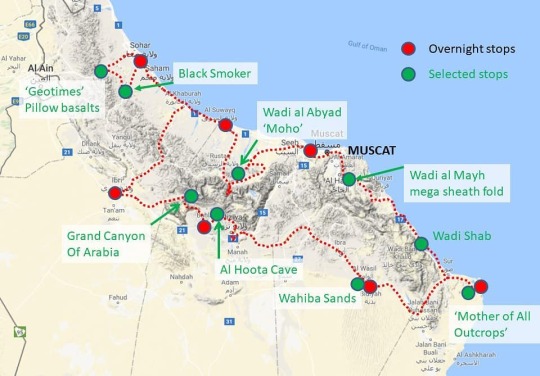
We are in Oman, our "Ocean crust and mountains of mantle" tour has begun. Our first stop tomorrow will be to see the Moho. (at Centara Muscat Hotel Oman) https://www.instagram.com/p/B9PcUSEJ0-C/?igshid=1alcowp2jlpew
0 notes
Text
We've just published our latest newsletter!
GeoWorld Travel Newsletter early 2020 🌍 - https://t.co/jjncFM1S92
0 notes
Photo
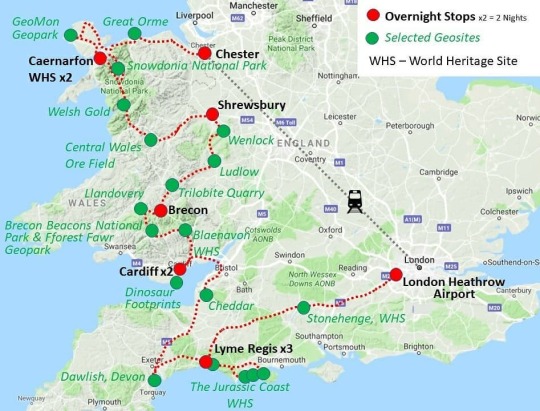
Does anyone fancy joining us for our #geology of #britain tour? It starts on April 29th at London Heathrow. Full itinerary here: https://www.geoworldtravel.com/britain.php Britain is one of the world's most geodiverse destinations, where is possible to see rocks of almost every geological time period. It is no wonder that the foundations of geological science were built here. Whilst the Highland Controversy raged in Scotland, the Devonian Controversy raged in England, leading to the naming of the Devonian Period. In addition, Wales not only lends its name to the Cambrian period, but also the Ordovician and Silurian periods too! On this special trip you will have the chance to search for Jurassic fossils in Lyme Regis and Ordovician trilobites in Wales, you will see Jurassic and Triassic dinosaur trackways, you will descend a coal mine and a prehistoric copper mine, and you'll even take a train ride to the summit of Wales's highest mountain. As well as all of this, you will also be able to walk behind South Wales's highest waterfall, wonder at the oldest tree in Europe, touch rocks that were formed in a subduction zone and visit many places whose names are now known throughout the world as geological periods of time. https://www.instagram.com/p/B7YJg3vJB-4/?igshid=px06bhhd57kd
0 notes
Text
Canary Islands 2019
Rounding off a very busy 2019, we led a tour to the Canary Islands just before Christmas. This is our trip blog. Happy New Year!
Canary Islands: Volcanic Island Hopping
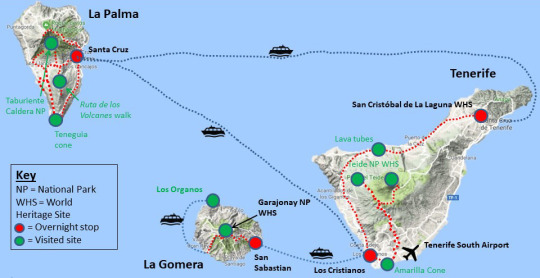
GeoWorld Travel’s ‘Canary Islands: Volcanic Island Hopping’ route map
Day one – Tenerife to La Palma
The tour group met on Tenerife in the afternoon before taking the ferry over to La Palma for the first night. En route to the ferry there was time for a bonus stop: Amarilla Phreatomagmatic vent. This tuff cone is morphologically different to…
View On WordPress
#caldera#Canary Islands#Cumbre Vieja#geology#geosite#geotourism#hotspot#island hopping#la gomera#la palma#landslide#los organos#National Park#Taburiente#Teide#tenerife#Volcanoes#World Heritage Site
0 notes
